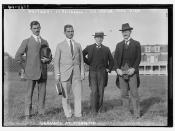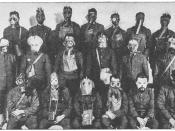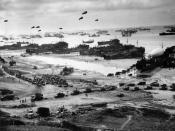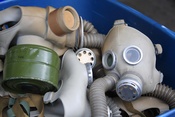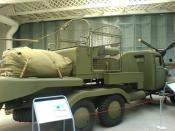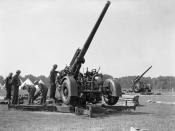Year 11 Coursework "ÃÂ Evacuees "ÃÂ Background In Brief "ÃÂ At the start of the Second World War, British cities were seen as being threatened by Aerial Bombardment from the Germans. In order to protect children from the massive destruction expected they were moved to areas of safety away from population centres. All people were asked to carry Gas-Masks, as it was feared that the Germans would use chemical weapons in the battle against Britain. Some loved evacuation some hated it.
The Effects of Aerial Warfare On Britain ÃÂ÷ 60,000 people were killed and 250,000 made homeless ÃÂ÷ Many factories, warehouses and Communications were destroyed ÃÂ÷ The effect of the Blitz was to bring the country closer together and reinforce a sense of unity against a common enemy ÃÂ÷ ARP Wardens ensured Blackouts were enforced in the major cities and made arrangements for the provision of shelter from the bombs ÃÂ÷ People built air-raid shelters inside (Morrison) and outside (Anderson) their homes.
ÃÂ÷ Sandbags, Barrage Balloons, Taped Windows, Search Lights and Anti-aircraft Guns became a common sight in major cities.
Evacuation City children were encouraged to move to safer areas of the country away from where the bombs would be dropped. Many Children were able to stay with relatives in the country. Others relied on the Government. The country was divided into areas "ÃÂ evacuation areas, neutral areas and reception areas. Children would be moved from the evacuation to the reception areas.
Who was moved? Children over five years old, pregnant mothers, mothers with children under five years old and disabled people Where were they moved from? London, Birmingham, Liverpool, Manchester, Sheffield, Leeds, Edinburgh, Glasgow, Newcastle, The Solent, Kent "ÃÂ later they were also moved from the south coast after Germany conquered France.
Where were they moved to? Safe country areas away from the big cities.
How were they moved? Those who could arrange to stay with relatives did so "ÃÂ over 2 million made these arrangements. The government sorted out another 1.5 million. Children were usually sorted out by their schools and whole classes left for the same areas of the country. Teachers had to go with them too.
Pupils did not know on which day they would be moved and had to be prepared. When they were moved, they had to take enough food for the day's travel. Some thought it was like a holiday outing. Many arrived at their destinations ill and very tired, some had soiled themselves.
Children had gas masks, bags and labels to identify them, brothers and sisters had to try and stay together. Waving goodbye was one of the hardest parts for both children and parents.
On arrival in a reception area, "Billets"ÃÂ had to be found for the children, these were homes willing to take evacuees -"Vackies"ÃÂ- in. Billeting agents were given the job of finding suitable homes; these usually took place in a village hall in the twilight after a long day of travel.
"We felt like cattle at an auction,"ÃÂ "If you were a child with glasses or spots then you were always left to the end."ÃÂ Some children failed to get chosen and the billeting Officer had to drive them around looking for homes.
Some children were put up in boarding schools and hotels. They had to sleep in dormitories, Some of the conditions were similar to prison camps! Was evacuation a success? In terms of numbers moved 3.5 million children were moved, some cities were more successful than others "ÃÂ 75% of Manchester children were evacuated, only 15% of Sheffield children.
Many children loved the experience of being in the country for the first time; others were homesick "ÃÂ mothers got very bored being away from the bright lights of the city.
Some evacuees ran away so they could return to the city, others were asked to return by anxious parents. When the bombs did not start to fall as expected in 1939, many evacuees returned home only to be evacuated again during the days of the "Blitz"ÃÂ a year later.
How did children respond to being evacuated? Some saw the experience of evacuation as a great adventure and loved the time spent in the countryside. In foster homes many were much better fed and treated than they would be in the cities, the experience brought home the realities of malnourishment which effected children from working class backgrounds. Some would sleep in beds and be bathed regularly for the first time.
Some children had nightmare experiences of evacuation: away from mother for the first time, lost, cold, without adequate clothing, treated like a piece of property at the billeting "auction"ÃÂ and being used as cheap manual labour. Many children wet the bed as a sign of distress. Children had to get used to new homes, new schools, and new adults to provide for them. Many would feel a sense of isolation, particularly if their parents did not write.
Many evacuees found the experience of returning home distressing, reunions with parents could be fraught and the cities grime and overcrowding was hard to get used to again.
Questions 1. What alternatives were there to evacuation? 2. Why would being evacuated be so distressing for many children? 3. Do you think that most evacuees were grateful for the experience? 4. What were the major benefits of moving to the countryside? 5. What were the major drawbacks of being moved to the countryside?
